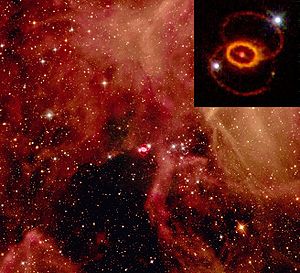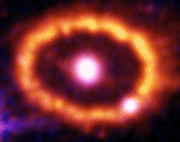SN 1987A
| SN 1987A | |
|---|---|
 Circumstellar rings around SN 1987A, with the ejecta from the supernova explosion at the center of the inner ring. |
|
| Observation data (Epoch J2000.0) | |
| Supernova type | Type II-P (unusual) |
| Remnant type | unknown |
| Host galaxy | Large Magellanic Cloud (LMC) |
| Constellation | Dorado |
| Right ascension | 05h 35m 28.03s (J2000) [1] |
| Declination | −69° 16′ 11.79″ (J2000) [1] |
| Galactic coordinates | unknown |
| Discovery date | 24 February 1987 (23:00 UTC) [2] |
| Peak magnitude (V) | +3 |
| Distance | 168,000 light-years, or 51.4 kpc |
| Physical characteristics | |
| Progenitor | Sanduleak -69° 202a |
| Progenitor type | B3 supergiant |
| Colour (B-V) | +0.085 |
| Notable features | Closest recorded supernova since invention of telescope |


SN 1987A was a supernova in the outskirts of the Tarantula Nebula in the Large Magellanic Cloud, a nearby dwarf galaxy. It occurred approximately 51.4 kiloparsecs from Earth,[1] close enough that it was visible to the naked eye. It could be seen from the Southern Hemisphere. It was the closest observed supernova since SN 1604, which occurred in the Milky Way itself. The light from the supernova reached Earth on February 23, 1987. As the first supernova discovered in 1987, it was labeled "1987A". Its brightness peaked in May with an apparent magnitude of about 3 and slowly declined in the following months. It was the first opportunity for modern astronomers to see a supernova up close.
It was discovered by Ian Shelton and Oscar Duhalde at the Las Campanas Observatory in Chile on February 24 1987, and within the same 24 hours independently by Albert Jones in New Zealand.[2] On March 4-12, 1987 it was observed from space by Astron, the largest ultraviolet space telescope of that time.[3]
Since 51.4 kiloparsecs is approximately 168,000 light-years, the cosmic event itself happened approximately 168,000 years prior to its observation in 1987.
Most supernovas grow dimmer with the passage of time as they release their energy. But the X-ray and radio emissions from 1987A grew brighter because its shock wave had crashed into a dense cloud of gas and dust.[4]
Contents |
Progenitor
Soon after the event was recorded, the progenitor star was identified as Sanduleak -69° 202a, a blue supergiant. This was an unexpected identification, because at the time a blue supergiant was not considered a possibility for a supernova event in existing models of high mass stellar evolution. Current understanding is that the progenitor was a binary system, the stars of which merged about 20,000 years before the explosion, producing a blue supergiant. Difficulties persist with this interpretation.[5]
Neutrino emissions
Approximately three hours before the visible light from SN 1987A reached the Earth, a burst of neutrinos was observed at three separate neutrino observatories. This is due to the neutrino emission (which occurs simultaneously with core collapse) preceding the emission of visible light (which occurs only after the shock wave reaches the stellar surface). At 7:35am Universal time, Kamiokande II detected 11 antineutrinos, IMB 8 antineutrinos and Baksan 5 antineutrinos, in a burst lasting less than 13 seconds.
These 24 observed events are commonly attributed to electron antineutrinos, rather than neutrinos, for the simple reason that these have a much larger interaction with detectors of this type, see e.g., [6]. This is a property of water- or scintillator-based instruments; recall on passing that other types of instruments, say the gallium-71-based ones, detect only electron neutrinos instead. Furthermore, there is no clear sign of directionality in the signal from SN1987A; however, the first event observed by Kamiokande-II points back to the supernova and could be possibly attributed to an elastic scattering reaction, due to a neutrino or to an antineutrino.
Although the actual neutrino count was only 24, it was a significant rise from the previously-observed background level. This was the first time neutrinos emitted from a supernova had been observed directly, and the observations were consistent with theoretical supernova models in which 99% of the energy of the collapse is radiated away in neutrinos. The observations are also consistent with the models' estimates of a total neutrino count of 1058 with a total energy of 1046 joules.[7]
Missing neutron star?
SN 1987A appears to be a core-collapse supernova, which should result in a neutron star. Since the supernova first became visible, astronomers have been searching for the collapsed core but have not detected it. The Hubble Space Telescope has taken images of the supernova regularly since August 1990. The images show no evidence of a neutron star. Three possibilities for the 'missing' neutron star are being considered. The first is that the neutron star is enshrouded in dense dust clouds so that it cannot be seen. The second is that large amounts of material fell back on the neutron star, so that it further collapsed into a black hole. The third possibility is that the collapsed core became a quark star.[8][9]
SN1987A distance and the speed of light
The three bright rings around SN 1987A are material from the stellar wind of the progenitor. These rings were ionized by the ultraviolet flash from the supernova explosion, and consequently began emitting in various emission lines. These rings did not "turn on" until several months after the supernova, and the turn-on process can be very accurately studied through spectroscopy. The rings are large enough for their angular size to be measured accurately: the inner ring is 0.808 arcseconds in radius. Using the distance light must have traveled to light up the inner ring as the base of a right angle triangle, and the angular size as seen from the Earth for the local angle, one can use basic trigonometry to calculate the distance to SN1987A, which is about 168,000 light-years.[10]
During its excursions into the red supergiant region of the HR-diagram, it threw off large amounts of material. 10 million years after it formed, its central temperature had reached 3.5 billion degrees and iron was being created. The core collapsed in less than a second and the infalling material rebounded causing a shock wave to pass through the star. This reached the surface a few hours later, traveling at the local speed of sound in the star, still being heated by the massive release of neutrinos and we observed the outburst on Earth some 160,000 years later. The material from the explosion is catching up with the material expelled during its red giant phase and heating it, so we observe ring structures around the star. There is a constant watch being kept to discover the neutron star at the centre, which is still hidden by the expanding debris.
The number of neutrinos released by the collapse of SN 1987A was really enormous, some 10^58 were released with a power of 10^46 watts, greater than the luminosity of all stars in all galaxies in our local group of galaxies. 1% of this power was used to destroy the star, the rest was carried away by the escaping neutrinos. Here on Earth we observed these neutrinos at the neutrino stations in Japan and Italy.

See also
- List of supernova remnants
References
- ↑ 1.0 1.1 1.2 "SN1987A in the Large Magellanic Cloud". Hubble Heritage Project. http://heritage.stsci.edu/1999/04/fast_facts.html. Retrieved 2006-07-25.
- ↑ 2.0 2.1 "IAUC4316: 1987A, N. Cen. 1986". 24 February 1987. http://cfa-www.harvard.edu/iauc/04300/04316.html.
- ↑ Observations on Astron: Supernova 1987A in the Large Magellanic Cloud
- ↑ ‘Wild Cousin’ Emerges from Family Tree of Sueprnova Newswise, Retrieved on September 25, 2008.
- ↑ Galactic Twins of the Nebula Around SN 1987A: Hints that LBVs may be supernova progenitors May 2007
- ↑ Mann, Alfred K. (1997). Shadow of a star: The neutrino story of Supernova 1987A. New York: W. H. Freeman. pp. 127. ISBN 0716730979. http://www.whfreeman.com/GeneralReaders/book.asp?disc=TRAD&id_product=1058001008&@id_course=1058000240.
- ↑ Improved analysis of SN1987A antineutrino events. G. Pagliaroli, F. Vissani, M.L. Costantini, A. Ianni, Astropart.Phys.31:163-176,2009.
- ↑ Chan, T. C.; Cheng, K. S.; Harko, T.; Lau, H. K.; Lin, L. M.; Suen, W. M.; Tian, X. L. (2009). Could the compact remnant of SN 1987A be a quark star?. arXiv:0902.0653.
- ↑ Parsons, Paul (February 21, 2009). "Quark star may hold secret to early universe". New Scientist. http://www.newscientist.com/article/mg20126964.700-quark-star-may-hold-secret-to-early-universe.html.
- ↑ Panagia, N.. "New Distance Determination to the LMC". Memorie della Societa Astronomia Italiana 69: 225. http://articles.adsabs.harvard.edu/cgi-bin/nph-iarticle_query?1998MmSAI..69..225P&data_type=PDF_HIGH&type=PRINTER&filetype=.pdf.
- Graves, G.J.M; et al. (2005). "Limits from the Hubble Space Telescope on a point source in SN 1987A". Astrophysical Journal 629: 944–959. doi:10.1086/431422. arXiv:astro-ph/0505066

External links
- Picture of Supernova 1987A
- More information on the discovery of SN 1987A
- Rochester Astronomy discovery timeline
- Light echoes from Sn1987a, Movie with real images by the group EROS2
- Animation of light echoes from SN1987A
- Supernova 1987A, by Richard McCray (astrophysicist, University of Colorado at Boulder)
- SN 1987A at ESA/Hubble
- Supernova 1987A, WIKISKY.ORG
- More information at Phil Plait's Bad Astronomy site
|
|||||||||||||||||||||||||||||